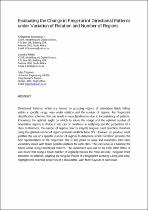 ResearchSpace
ResearchSpace
Evaluating the change in fingerprint directional patterns under variation of rotation and number of regions
JavaScript is disabled for your browser. Some features of this site may not work without it.
- ResearchSpace
- →
- Research Publications/Outputs
- →
- Conference Publications
- →
- View Item
| dc.contributor.author |
Dorasamy, K

|
|
| dc.contributor.author |
Webb, L

|
|
| dc.contributor.author |
Tapamo, J

|
|
| dc.date.accessioned | 2016-04-22T07:28:20Z | |
| dc.date.available | 2016-04-22T07:28:20Z | |
| dc.date.issued | 2015-09 | |
| dc.identifier.citation | Dorasamy, K, Webb, L and Tapamo, J. 2015. Evaluating the change in fingerprint directional patterns under variation of rotation and number of regions. In: 14th International Conference of the Biometrics Special Interest Group (BIOSIG), 9-11 September 2015, Darmstadt, Germany | en_US |
| dc.identifier.uri | http://ieeexplore.ieee.org/xpls/abs_all.jsp?arnumber=7314601&tag=1 | |
| dc.identifier.uri | http://hdl.handle.net/10204/8513 | |
| dc.description | 14th International Conference of the Biometrics Special Interest Group (BIOSIG), 9-11 September 2015, Darmstadt, Germany. Due to copyright restrictions, the attached PDF file only contains the abstract of the full text item. For access to the full text item, please consult the publisher's website | en_US |
| dc.description.abstract | Directional Patterns, which are formed by grouping regions of orientation fields falling within a specific range, vary under rotation and the number of regions. For fingerprint classification schemes, this can result in missclassification due to inconsistency of patterns. Knowning the optimal angle by which to rotate the image and the optimal number of orientation regions to divide it into can be beneficial in analysing specific propertises of a class. Futhermore, the number of regions directly imapcts singular point detection, therefore using the optimal number of regions prevents multiple false SPs. However, no previous work justifies the use of a specific number of regions to determine which condition provides the best representation of the fingerprint that is less prone to noise and minimizes inter-class variability issues with fewer possible patterns for each class. This can serve as a baseline for future works using Directional Patterns. The experiment was test on the FVC 2002 DB1a. It was found that using a small number of regionsproduces the most accurate Singular Point detection. In addition, aligning the Singular Points of a fingerprint containg a loop and delta, highlights the essential properties of a class better, with fewer layouts of each class. | en_US |
| dc.language.iso | en | en_US |
| dc.publisher | IEEE | en_US |
| dc.relation.ispartofseries | Workflow;16287 | |
| dc.subject | Fingerprints | en_US |
| dc.subject | Directional patterns | en_US |
| dc.subject | Orientation fields | en_US |
| dc.subject | Singular points | en_US |
| dc.subject | Fingerprint classification | en_US |
| dc.subject | Fingerprint matching | en_US |
| dc.title | Evaluating the change in fingerprint directional patterns under variation of rotation and number of regions | en_US |
| dc.type | Conference Presentation | en_US |
| dc.identifier.apacitation | Dorasamy, K., Webb, L., & Tapamo, J. (2015). Evaluating the change in fingerprint directional patterns under variation of rotation and number of regions. IEEE. http://hdl.handle.net/10204/8513 | en_ZA |
| dc.identifier.chicagocitation | Dorasamy, K, L Webb, and J Tapamo. "Evaluating the change in fingerprint directional patterns under variation of rotation and number of regions." (2015): http://hdl.handle.net/10204/8513 | en_ZA |
| dc.identifier.vancouvercitation | Dorasamy K, Webb L, Tapamo J, Evaluating the change in fingerprint directional patterns under variation of rotation and number of regions; IEEE; 2015. http://hdl.handle.net/10204/8513 . | en_ZA |
| dc.identifier.ris | TY - Conference Presentation AU - Dorasamy, K AU - Webb, L AU - Tapamo, J AB - Directional Patterns, which are formed by grouping regions of orientation fields falling within a specific range, vary under rotation and the number of regions. For fingerprint classification schemes, this can result in missclassification due to inconsistency of patterns. Knowning the optimal angle by which to rotate the image and the optimal number of orientation regions to divide it into can be beneficial in analysing specific propertises of a class. Futhermore, the number of regions directly imapcts singular point detection, therefore using the optimal number of regions prevents multiple false SPs. However, no previous work justifies the use of a specific number of regions to determine which condition provides the best representation of the fingerprint that is less prone to noise and minimizes inter-class variability issues with fewer possible patterns for each class. This can serve as a baseline for future works using Directional Patterns. The experiment was test on the FVC 2002 DB1a. It was found that using a small number of regionsproduces the most accurate Singular Point detection. In addition, aligning the Singular Points of a fingerprint containg a loop and delta, highlights the essential properties of a class better, with fewer layouts of each class. DA - 2015-09 DB - ResearchSpace DP - CSIR KW - Fingerprints KW - Directional patterns KW - Orientation fields KW - Singular points KW - Fingerprint classification KW - Fingerprint matching LK - https://researchspace.csir.co.za PY - 2015 T1 - Evaluating the change in fingerprint directional patterns under variation of rotation and number of regions TI - Evaluating the change in fingerprint directional patterns under variation of rotation and number of regions UR - http://hdl.handle.net/10204/8513 ER - | en_ZA |





